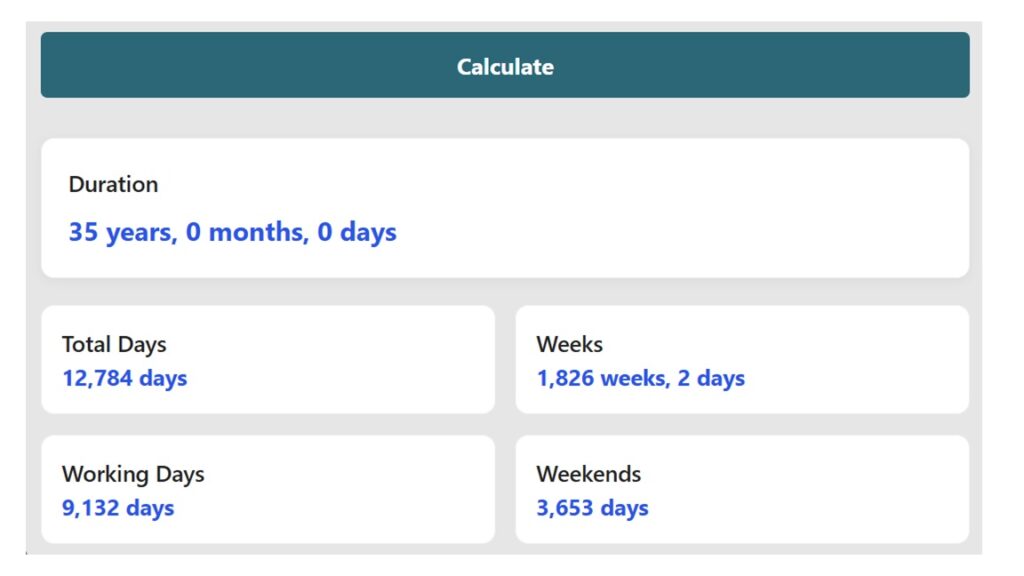Smart Date Calculators Online
🗓️ Date Difference Calculator – A Smarter Way to Track Time
Ever needed to know exactly how many days are between two important dates? Whether you’re planning a project, organizing an event, or just curious about how long something lasted, our Date Difference Calculator has you covered. It’s more than just a tool—it’s your timekeeping sidekick! What you will find in our Smart Date Calculator it Calculate Dates Instantly Online.
🔧 What This Tool Does
This fabulous calculator lets you find the precise duration between opening and closing two dates, including:
- Years, months, and days
- Total days and weeks
- Working days (excluding weekends)
And for those who need extra precision, you can even include specific start and end times.
Final Output or Results of our Smart Date Calculator

🌟 Key Features
- Accurate Results: Get exact counts down to the day, or include time for even more detail.
- Multiple Formats: Results are shown in different formats—days, weeks, and business days.
- Smart Logic: It doesn’t matter which date you enter first; the calculator handles it.
- Business Use: Perfect for professionals managing timelines, contracts, or deadlines.
💼 Common Use Cases
- Planning project timelines
- Calculating age differences
- Scheduling events
- Managing contract durations
- Counting workdays or setting deadlines
🧭 How to Use It
- Enter any start date (and time, if needed).
- Enter your end date (and time, if needed).
- Click “Calculate Difference” to see the results.
- Hit “Reset” to start over any time.
Whether you’re organizing your next vacation or calculating how long until retirement, this tool gives you the exact information you need—fast and easy.
📜 A Brief History of the Gregorian Calendar
The calendar we use today—the Gregorian calendar—has quite a story. Introduced by Pope Gregory XIII in 1582, it was designed to fix flaws in earlier systems, particularly the Julian calendar, which had drifted out of sync with the solar year by about 10 days.
Before that, ancient Romans used a lunar calendar based on moon phases, which was chaotic and inconsistent. Over time, they refined it, adding months like January and February, and eventually Julius Caesar introduced a more structured calendar in 46 BC with 365 days and a leap year every four years.
However, this system still wasn’t perfect—it gained about 11 minutes per year, which added up. By the 1500s, the calendar had drifted too far, and Pope Gregory corrected it by skipping 10 days and updating leap year rules. Under this new system:
- Only century years divisible by 400 are called leap years.
- The current calendar now drifts just 1 day every 3,030 years—a massive improvement!
Adoption took time across countries, but the Gregorian calendar eventually became the global standard and remains the most widely used calendar system today.
🎉 Understanding Holidays
Holidays are special days recognized either by law or tradition, typically offering a break from work or school. But their meaning and treatment vary by country to country and culture to culture.
In the U.S., “holidays” refer to nationally or culturally recognized days off, while time off for personal travel is called a “vacation.” In the UK and other countries, “holiday” might refer to both.
🔄 Fixed vs. Floating Holidays
- Fixed holidays fall on the same date each year (e.g., New Year’s Day on January 1).
- Floating holidays change dates each year but stick to a specific day of the week (e.g., Thanksgiving is always the fourth Thursday of November).
Some notable U.S. examples:
- Martin Luther King Jr. Day – Third Monday in January
- Thanksgiving – Fourth Thursday in November
🏢 Business & Federal Holidays
This tool focuses on U.S. holidays, but you can manually enter your own country holidays from any where in the world. You can also exclude specific holidays if they don’t apply to your calculation.
In the U.S., federal holidays are recognized by the government—federal offices close, and federal employees get paid time off. But in the private sector, it’s up to the employer whether or not to observe them. Some employees may receive holiday pay if they work on these days.
🗓️ Example: Federal Holidays for 2025–2026
(Here you can add tables for U.S. federal holidays by year)
✅ Final Thoughts
Whether you’re scheduling your next big launch, calculating how long you’ve known someone, or figuring out how many working days are left before a deadline, our Date Difference Calculator brings clarity to time.
It’s simple, accurate, and built with real-life needs in mind—making every day count just a little more.